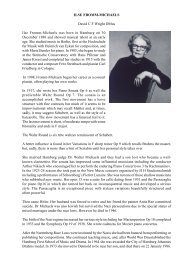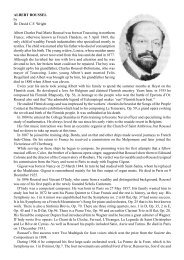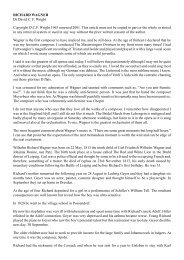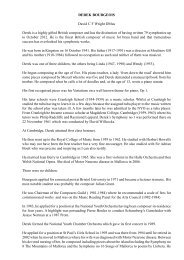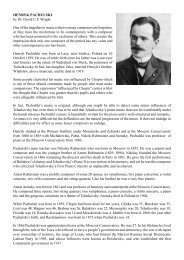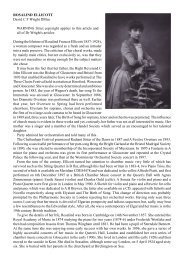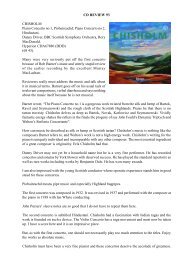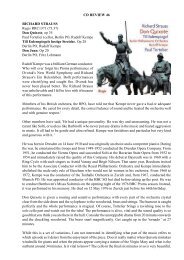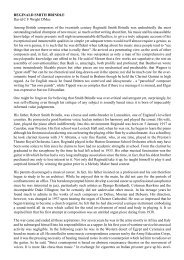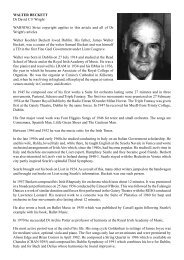You also want an ePaper? Increase the reach of your titles
YUMPU automatically turns print PDFs into web optimized ePapers that Google loves.
parodies of the liturgy are cleverly woven. There is a tremendous moment when the ghost of Joyce’s mother<br />
appears. The tension and drama is compulsive. The fourth epiphany is, in turn, both tranquil and menacing.<br />
The cor anglais depicts Joyce’s father singing affectedly the Irish melody The Shores of Amerikay. The fifth<br />
epiphany portrays the two sides of Joyce - the would-be man of the world and the artist. This is followed by<br />
the final epiphany, a March Macabre which echoes the earlier Habanera where the underworld, ribald laughter<br />
and menace are all portrayed with gripping realism. The epilogue echoes earlier ideas but now, for the first<br />
time, the full note-row is stated in its entirety by the solo trumpet as a tranquil arioso.<br />
As with the Symphony no 2 this work is a powerful utterance rich with its varied moods and colours, its<br />
rugged and exhilarating orchestration as well as some delightful and delicate sounds; the portrayal of the<br />
author’s life, without the need of words, is achieved with lucidity which feature had been earlier displayed<br />
with Jonathan Swift.<br />
The Symphony no 3 was completed in 1984 and is subtitled Refrains. The first movement features exotic<br />
music contending with a more tonal posture. The second has Renaissance elements and is a neo-romantic<br />
cantilena, whereas the finale is an extended march in which parodies of various march styles are set against<br />
a minimalist style in which unchanging harmony is developed by added colours and dynamics. This fine<br />
work was very well received. The Symphony no 4 is a succinct and effective work.<br />
The large Symphonic work telling the history of Dublin has been opined as his Symphony no.5<br />
On 2 March 1984 the National Concert Hall in Dublin witnessed the first performance of the mammoth ten<br />
movement Ultima Rerum which the composer described as a "global Requiem Symphony reaching beyond<br />
the traditional framework and covering a wide span of human thought on the subject of death and its aftermath".<br />
The framework is the traditional Requiem of the Roman Ritual with additional texts including the comments<br />
of non-Christian religion with quotations from the Koran, the Navajo Indians, the Norse Edda and the<br />
fantastic apocalyptic poetry of James Elroy Flecker, William Blake and Walt Whitman; elegiac writings<br />
from the ritualistic poems of the Italian sceptic Giacomo Leopardi to the poignant In Memoriam of Tennyson.<br />
Old Irish visionary literature appears in lines from Tidings of Doomsday in Lebor na hUidhre. The inclusion<br />
of such varied material may be worrying because it is unartistically unnatural and in any long work interest<br />
can be adversely affected by the diversity of material as well as the quality and changing styles of the music.<br />
For example, many admit that the symphonies of such figures as Mahler and Bruckner have superb moments<br />
but also passages that if they were not included would enhance enjoyment and overall continuity of such<br />
works. Ultima Rerum may be an unequal work but it is a magnificent achievement and concept. Many<br />
present at its first performance hailed it as "a sublime experience" even if it was sometimes a flawed rendering<br />
of the score. Perhaps the truly memorable moments of this work - and there are many - make up for the lessthan-satisfactory<br />
passages. For example, some will prefer the superior power and drama of Verdi’s Dies Irae<br />
to <strong>Victory</strong>’s. Yet for all this it is a compassionate and human work receiving lavish praise in the Irish press.<br />
The music of <strong>Gerard</strong> <strong>Victory</strong> occupies a very special place in Irish serious music and what is truly remarkable<br />
is that his light pieces such as the delightful Capriccio for violin and orchestra or the engaging short opera<br />
The Music hath mischief are not trite or banal. This composer has lifted such music out of the accusing depth<br />
of being not quite respectable to a higher level and set a higher standard in this field than ever before. Yet it<br />
is in his most serious works that there is a composer who can certainly compete with the best of contemporary<br />
composers while in a different but rewarding mode he rivals the exuberance of such figures as Malcolm<br />
Arnold.<br />
What we have in <strong>Gerard</strong> <strong>Victory</strong> is a largely unknown but distinguished and prolific composer. He has nine<br />
operas, nine works for solo instrument and orchestra, much choral and vocal music, chamber music and<br />
songs to his name. Above all, he has a marvellous and unfailing capacity for communication to which all his<br />
works testify.<br />
<strong>Dr</strong> <strong>Victory</strong> went into hospital in March 1995. A week earlier we shared our final long conversation. He<br />
sought to reassure me that his medical problem was a minor one but we both knew that it was not. He died on



